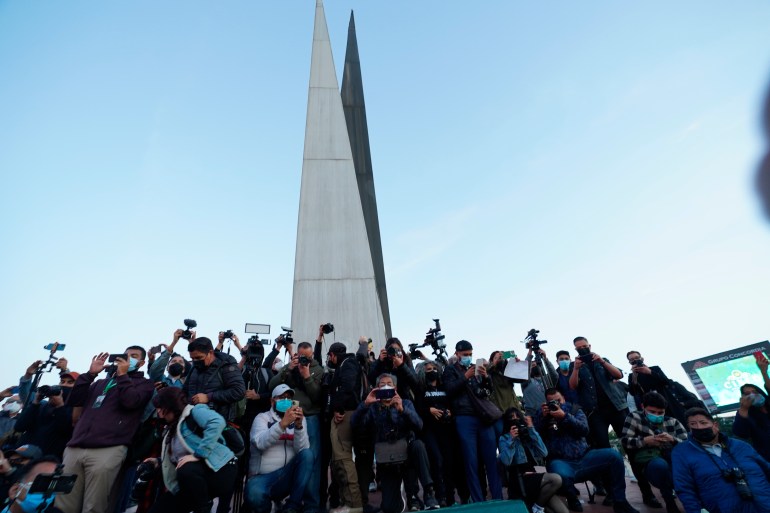Fourth journalist killed in Mexico in less than a month
Roberto Toledo’s killing comes after his employer says the outlet received threats for reporting on government corruption.

A news outlet in Mexico’s Michoacan state says one of its employees, Roberto Toledo, has become the fourth media worker killed in the country in less than a month.
The weeks-long spate of killings has already sparked protests, with press freedom groups urging the government to do more to protect journalists.
Keep reading
list of 3 itemsMexico sees rising COVID cases, especially in tourism hotspots
In Pictures: The Indigenous town in Mexico living on remittances
Two of those killed in recent weeks, including Toledo, had already been part of federal protection programmes for journalists while one had been about to join, according to rights groups.
“For exposing corrupt administrations and corrupt officials and politicians, today that led to the death of one of our colleagues,” Armando Linares, director of Monitor Michoacan, said following Toledo’s killing on Monday.
Linares said Toledo, who had worked as a videographer for the news outlet for two years, had been preparing to record a regular video column at the law offices of the website’s deputy director when he was shot by the attackers.

The Michoacan attorney general’s office said in a statement that Toledo died from his wounds. State authorities said they were investigating the killing but did not provide further details.
In a video message, Linares said the outlet had been reporting on several sensitive stories, including three Indigenous communities working towards self-government, organised crime in the area, and illegal logging and corruption in local government.
He said the website had previously received threats regarding its reporting on government corruption.
“The Monitor Michoacan team has suffered weeks, months of death threats. We know where all of this comes from,” Linares said, without identifying those he thought responsible.
He said he was now under the protection of the National Guard.
Spate of killings
Mexico continues to be one of the most dangerous countries for reporters in the world. Human rights group Article 19 has recorded the murders of at least 145 journalists from 2000 to 2021, including seven last year.
2022 has proven particularly deadly.
Toledo’s killing came after two journalists – photographer Margarito Martinez and reporter Lourdes Maldonado Lopez – were killed within a week of each other in the border city of Tijuana. They were fatally shot on January 17 and January 23, respectively.
Rights groups say Maldonado Lopez had been enrolled in the $23m-a-year federal programme to protect journalists and rights defenders since last December. Martinez had been in the process of applying for the programme when he was killed.
The National Academy of Radio and Television Journalists said on Monday Toledo was enrolled in the same protection system known as “el mecanismo” or the mechanism. Protections under the programme can range from carrying a panic button to alert authorities, to surveillance cameras installed around a home, and even bodyguards.
Despite the programme, Interior Undersecretary Alejandro Encinas has said that more than 90 percent of murders of journalists and rights defenders remain unsolved.
Reporter Jose Luis Gamboa was also killed in the coastal state of Veracruz in an attack on January 10. He was not known to be enrolled in the programme.
One month.
One Mexican reporter was shot at and fled his attackers.
One Mexican reporter was gravely wounded with a knife.
Four Mexican reporters were murdered.
It’s not even February yet.
— Jan-Albert Hootsen 🇳🇱🇲🇽 (@jahootsen) January 31, 2022
Jesus Ramirez, spokesman for President Andres Manuel Lopez Obrador, said on Twitter that the administration condemned Toledo’s killing.
“We will work together with the state and municipal governments to clear up the case,” Ramirez wrote. “We will not allow impunity. We defend freedom of expression and the right to information.”
In a subsequent message, Ramirez said the initial investigation suggested Toledo worked in a legal office, not as a journalist.
Jan-Albert Hootsen, the Mexico representative for the Committee to Protect Journalists (CPJ), said Toledo worked as a camera operator and video editor for Monitor Michoacan.
Hootsen said the CPJ is “classifying him as a media worker or press worker”.
“One Month. One Mexican reporter was shot at and fled his attackers. One Mexican reporter was gravely wounded with a knife. Four Mexican reporters were murdered,” Hootsen tweeted, also referring to two non-fatal attacks on journalists in the state of Yucatan and Oaxaca that occurred in recent weeks.
“It’s not even February yet,” he wrote.